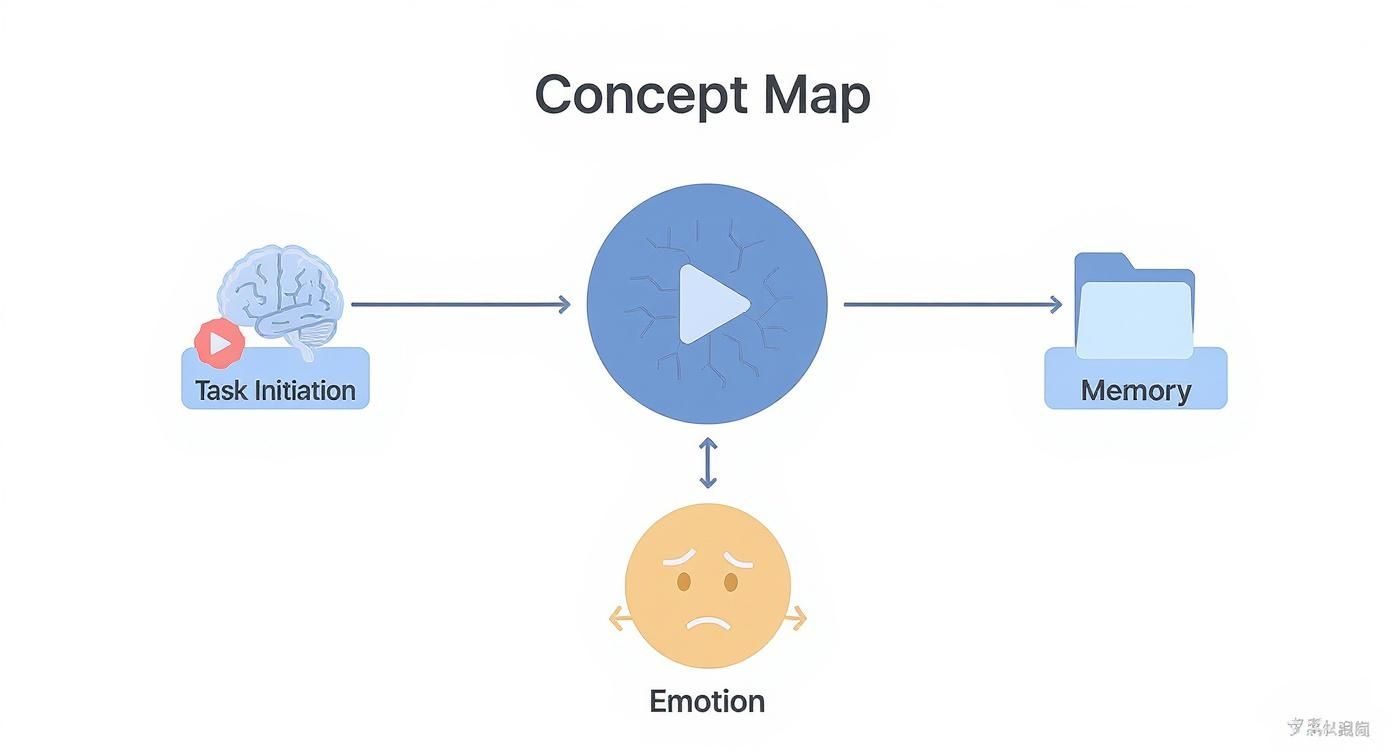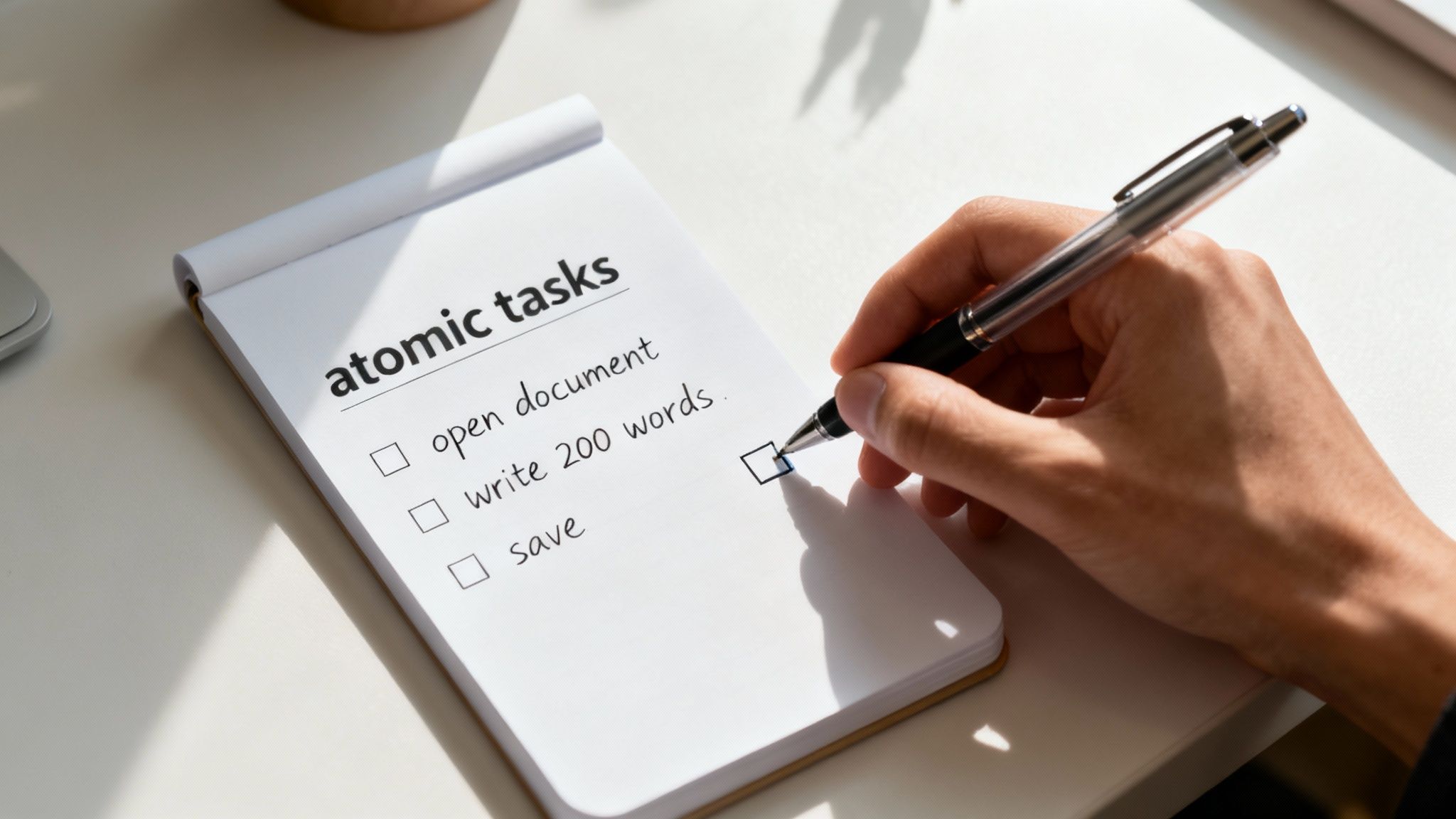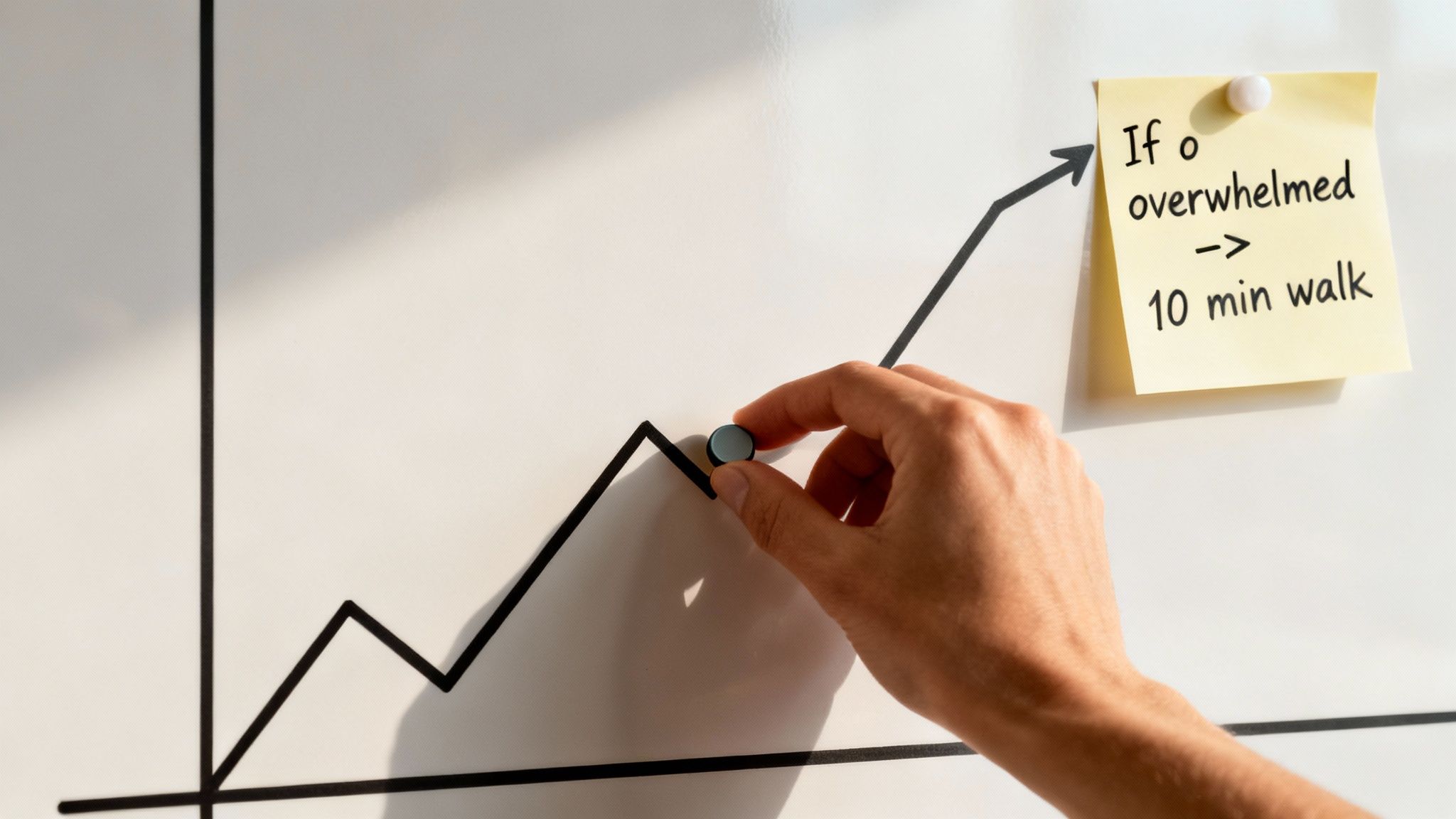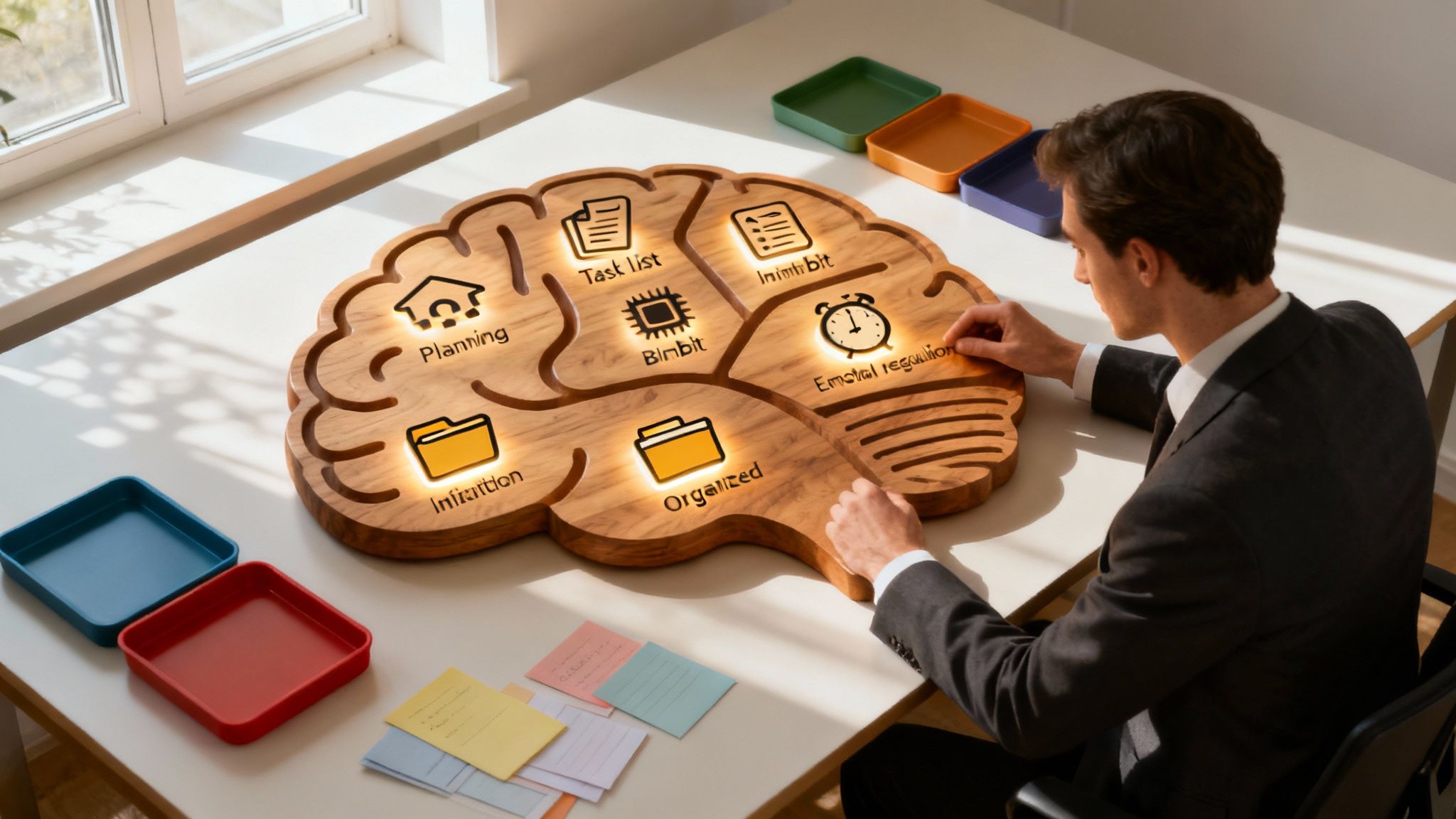Does that pile of half-finished projects feel familiar? If you’ve ever felt a surge of excitement for a new idea, only to have it fizzle out, you’re not alone. This pattern isn’t a personal failing. Learning how to finish what you start isn’t about forcing more willpower; it’s about understanding your brain’s unique wiring and working with it, not against it.
If you recognize yourself in this struggle, you’re in the right place. Let’s explore why this happens and find compassionate, practical ways to change the pattern.
The Real Reason You Can’t Finish Projects
That stack of unread books, the abandoned creative hobby, or that half-written email sitting in your drafts isn't proof of some deep character flaw. More often than not, it’s a sign of a mismatch between what a task demands and how your brain’s executive functions operate.
For many of us, especially those with ADHD, the struggle to see things through is deeply rooted in how the brain handles certain processes. These aren't issues of laziness or not wanting it enough; they are neurobiological hurdles that can make follow-through feel nearly impossible. Have you noticed this pattern in your own life?
Unpacking the Cognitive Roadblocks
Let's gently break down the core functions that can turn a straight path into a tangled mess. You might recognize yourself in these patterns:
- Task Initiation: This is the mental leap required to just get started. When a project feels huge, vague, or just plain boring, our brain can hit a wall, leading straight to procrastination. It’s not that you don’t want to do it; it’s that the "on" switch is hard to find.
- Emotional Regulation: Finishing something means pushing through the inevitable moments of boredom, frustration, and self-doubt. If those negative feelings easily throw you off course, sticking with a task when the initial excitement fades becomes a massive effort.
- Working Memory: Think of this as your brain’s temporary sticky note—it holds the crucial info you need while you're in the middle of something. When working memory is shaky, you might forget your original goal or lose track of the next step, causing you to give up out of sheer confusion.
🔬 Scientific Takeaway: This whole cycle of starting strong and then losing steam is a common experience for people with what's known as executive dysfunction. It’s not about having bad intentions; it’s about needing the right kind of support for your brain.
Just recognizing these patterns for what they are—neurobiological challenges, not character flaws—is the first, most powerful step. When you stop blaming yourself, you can finally start building a system that actually supports you. It’s a shift from self-criticism to genuine self-understanding.
💡 Insight: The goal isn't to magically become a perfect project-finishing machine overnight. It's about developing compassionate awareness of your own patterns and finding practical strategies that lower the barriers to getting things done. Tools like the Inflow app are designed specifically to help you build these skills, offering science-backed techniques to manage procrastination and build momentum.
Pinpoint Your Personal Project Roadblocks
Before we can talk about how to finish what you start, let's get curious about what’s stopping you. Think of this as a gentle diagnostic check to figure out the specific barriers that keep popping up between your brilliant idea and the finish line.
Every half-done project tells a story. For a lot of us, the plot twist happens right in what’s called the “messy middle”—that tricky phase when the initial dopamine hit of a new idea wears off and the reality of the actual work sinks in. Does that sound familiar?
What’s Your Sticking Point?
Another common scenario is “goal ambiguity.” This happens when the final outcome feels so fuzzy or just plain huge that you have no idea where to even begin. It’s like trying to build IKEA furniture with instructions that are just a blurry photo; eventually, you’re going to give up and walk away.
Most of these roadblocks fall into a few key categories:
- Emotional Barriers: This is when feelings like fear of failure or perfectionism grab the steering wheel. The anxiety of not doing something perfectly can be so paralyzing that it feels much safer not to do it at all. This is a huge reason behind why people procrastinate.
- Cognitive Barriers: These are the hurdles related to planning and thinking. This might look like overcomplicating a simple task until it feels insurmountable, or struggling with the executive functions required to map out the steps in a logical order.
- Environmental Barriers: Let's be real, sometimes the biggest obstacle is your immediate surroundings. Constant interruptions, a cluttered workspace, or not having the right tools can completely drain your focus.

As you can see, not finishing things is rarely about a single issue. It's usually a cocktail of cognitive and emotional factors working together.
Identifying Your Pattern is Key
This isn't just a personal struggle; it’s a massive challenge even for huge organizations. The worldwide success rate of complex digital transformation projects is a stunningly low 35%, according to data transformation challenges. This just goes to show how incredibly hard it is to see complex initiatives through. The companies that do succeed are the ones that identify their specific roadblocks and build clear strategies to overcome them.
🔬 Scientific Takeaway: Getting clear on your personal "why"—why you stop—is the most crucial first step. It shifts the problem from “What’s wrong with me?” to “What’s getting in my way, and how can I fix it?”
This kind of self-awareness is a cornerstone of cognitive behavioral therapy (CBT), which is the science-backed approach we use in the Inflow app. Once you understand your unique sticking points, you can start building a personalized strategy that actually works for you.
Break It Down to Build Real Momentum

You've probably heard the "break down your big goals" advice a million times. But if it were that simple, you wouldn't be reading this, right? The real reason this advice often falls flat is that our idea of a “small” step is often still way too big for a brain struggling with task initiation.
A task like “write report” might sound simple, but it’s secretly a dozen hidden sub-tasks: find the data, create an outline, write a draft, find sources, edit… the list goes on. This is where the real secret lies: you don't just break things down, you shrink them until they're almost effortless.
From Vague Goals to Atomic Tasks
Let's ditch the old approach. Instead of just making a to-do list, we’re going to define atomic tasks. An atomic task is an action so tiny and specific that it feels almost ridiculous not to do it.
🔬 Scientific Takeaway: This isn't just a mind trick; it's rooted in neuroscience. Every time you complete a task—no matter how small—your brain releases a tiny bit of dopamine, the neurotransmitter tied to motivation. Checking off an atomic task creates a tiny reward loop that makes you want to tackle the next thing, creating a powerful chain reaction of momentum.
💡 Tip:
- Instead of: "Organize the garage"
- Try: "Take one bag of trash out to the bin."
- Instead of: "Write the report"
- Try: "Open the document and write one sentence."
The goal is to lower the barrier for entry so much that your brain doesn't have a chance to resist. You’re not trying to conquer the whole project at once; you’re just focusing on the very next, single, physical action.
Reverse-Engineer Your Way to the Finish Line
A seriously powerful way to map out these atomic tasks is to work backward from your goal. Start by picturing the finished project. Then, ask yourself: “What’s the very last thing I need to do right before it’s totally done?” Keep asking that question, working your way back until you land on the very first, laughably simple step you need to take right now.
This process demystifies the work and provides a concrete roadmap, transforming a daunting, foggy goal into a clear, linear path of non-intimidating actions.
When you apply this method to your own life, you’re basically creating a better project plan for your brain. It's one of the most effective ways to build to-do lists that actually work for you. Have you ever noticed how a single vague task on your list can completely derail your entire day?
Design an Environment That Supports Completion

Your ability to follow through is deeply tied to your surroundings. We often think of willpower as some internal muscle we just need to strengthen, but what if the real secret is outside of yourself? What if it's about designing a space that makes it easier to succeed?
A core idea here is friction reduction—making it ridiculously easy to do the things you want to do and much harder to get sidetracked.
Make the Right Thing the Easy Thing
What’s friction? It’s any tiny obstacle standing between you and the task. For a brain that struggles with task initiation, even the smallest hurdles can feel like massive walls. The trick is to remove that friction before you even try to start.
Laying out your workout clothes the night before doesn't just save five minutes in the morning. It eliminates a dozen micro-decisions your tired brain would have to make, drastically lowering the odds you'll just hit snooze.
💡 Insight: By intentionally designing your environment, you're essentially outsourcing your willpower. You make the good choice the path of least resistance, giving your brain fewer chances to talk you out of it.
Work With Your Energy, Not Against It
A huge piece of your "environment" is your internal state—specifically, your energy levels. For many of us, especially those with ADHD, fighting against our natural biological rhythms is a fast track to burnout.
This is where understanding your chronotype—your body’s natural tendency to sleep and be alert at certain times—becomes a total game-changer.
Instead of forcing yourself to tackle a complex report at 8 a.m. because you feel like you should, try scheduling that deep work for when you naturally feel sharpest. Honoring your peak energy hours isn’t lazy; it’s a brilliant strategy for getting things done without burning out.
✅ Quick Environmental Audit Checklist
- Clear the Clutter: Is your desk covered in visual reminders of other unfinished projects? A clear space can genuinely lead to a clearer mind.
- Prep Your Tools: Is everything you need for your very next task open and ready to go? Think software, documents, supplies.
- Silence the Noise: Beyond phone notifications, what about all those browser tabs? If you need help wrangling digital distractions, check out our guide to the best productivity apps for ADHD.
- Schedule by Energy: Look at your to-do list for tomorrow. Are your toughest tasks scheduled during your known peak focus times?
By asking these questions, you start to see your environment not as a distraction to overcome, but as a powerful ally. Have you noticed how your surroundings affect your focus?
Navigate Setbacks and Keep Moving Forward

Let's be real: no project is a straight line. It’s almost always a winding path, full of unexpected hurdles, frustrating dips in motivation, and moments where you seriously question what you were even thinking.
Learning how to finish what you start isn’t about perfectly avoiding these setbacks. It’s about learning how to handle them without giving up.
The biggest hurdle is often your own mindset. When you miss a self-imposed deadline, it’s easy for that inner critic to start screaming "failure." But what if you saw it as data instead? A missed deadline isn't a moral failing; it’s just information. It tells you your timeline was too optimistic or a certain task needed more energy than you budgeted for.
This is where self-compassion becomes a non-negotiable tool. Instead of beating yourself up, you can get curious. This is the key difference between making a smart pivot and just quitting. Quitting comes from a place of frustration and shame. A strategic pivot comes from looking at the facts and making an informed course correction.
Prepare for Obstacles Before They Happen
One of the most effective ways to build this kind of psychological flexibility is a technique from CBT called If-Then planning. It’s a profound way to decide ahead of time how you'll handle common obstacles.
The structure is simple: "If [this specific thing happens], then I will [do this specific action]."
💡 Tip:
- If I start feeling totally overwhelmed by the project, then I will close my laptop and go for a 10-minute walk.
- If I get stuck on one part for more than 20 minutes, then I will switch to a different, easier task to regain momentum.
- If I feel that magnetic pull to procrastinate on social media, then I will set a timer and work for just five more minutes before I let myself take a break.
This simple trick automates your response to predictable challenges, taking the decision-making burden off your already-tired brain.
Refuel Your Motivation Along the Way
The secret to staying in motion is to celebrate the journey, not just obsess over the finish line. Acknowledge and reward the small wins. Did you finish a tough task? Did you stick to your plan even when you really didn't want to? That’s a victory. Celebrate it.
Visually tracking your progress can also be a huge motivator. Use a simple checklist, a habit tracker, or even just stick colored Post-it notes on a wall. Seeing how far you’ve come is a tangible reminder that your efforts are adding up. Sometimes, that's the exact fuel you need to keep going.
Got Questions About Finishing Projects? Let's Get Them Answered.
Even with the best strategies, you’re still going to hit a wall. Certain questions pop up time and time again. Let's tackle some of the most common hurdles you'll face when you're learning how to actually finish what you start.
"What If I Lose Interest Halfway Through?"
This is incredibly common, especially for creative and neurodivergent minds. When the initial spark of excitement fizzles out, the first step is to get curious. Are you just bored, or has the project genuinely run its course?
Reconnect with your original "why." What got you so fired up about this in the first place? If that reason still feels solid, you probably just need to shake things up.
💡 Try these simple shifts to get your momentum back:
- Change your scenery. Work from a coffee shop, the library, or even just a different room in your house.
- Give yourself permission to skip ahead. Jump to a different, more interesting part of the project. You don't always have to work linearly.
- Bring someone else in. Collaborate with a friend to get a fresh perspective and some accountability.
Sometimes, all it takes is committing to just 15 minutes. Just show up for the "boring" task for 15 minutes, and you might push through the dip.
But what if the project is truly no longer relevant? It's okay to let it go. This isn't failing; it's strategic quitting. The goal is to finish what matters, not everything you ever start.
"How Do I Handle Perfectionism That Stops Me Cold?"
Perfectionism is often just fear wearing a fancy disguise—fear of being judged or not being good enough. The most powerful way to fight it is to redefine what "done" actually means.
Stop aiming for an imaginary standard of "perfect." Instead, shift your target to "good enough for now." Before you start a project, write down a few clear, objective criteria for what completion actually looks like.
For example, a "done" blog post is one that's been spell-checked and covers its three main points. It is not one that has the most beautiful, award-winning prose ever written.
Get in the habit of finishing projects that are at 80-90% of your ideal. The real-world feedback you get from a completed, imperfect project is infinitely more valuable than the silence surrounding a "perfect" one hiding in your drafts folder. Celebrate the simple act of finishing as a victory in itself.
"I Have Way Too Many Projects. How Do I Choose Just One?"
Ah, the classic overwhelm scenario. When you try to work on everything at once, you guarantee that nothing gets finished. The only way out is to practice ruthless prioritization.
Here's a simple way to do it. Score your projects on two key factors:
- Impact: How much will finishing this really benefit me or my goals?
- Effort: How much time and energy will this realistically take?
Always start with a high-impact, low-effort project. This gives you a quick win, a much-needed boost of dopamine, and the momentum to tackle something bigger.
The most important part? Limit your Work in Progress (WIP). Force yourself to focus on only one to three projects at a time. Everything else goes on a "Someday/Maybe" list. This isn't saying "no" forever; it's just saying "not right now."
If you struggle with this kind of prioritization (and most of us do), the Inflow app has guided programs that teach you how to manage that feeling of being pulled in a million directions. You can see if our approach feels like a good fit by taking our quiz.







